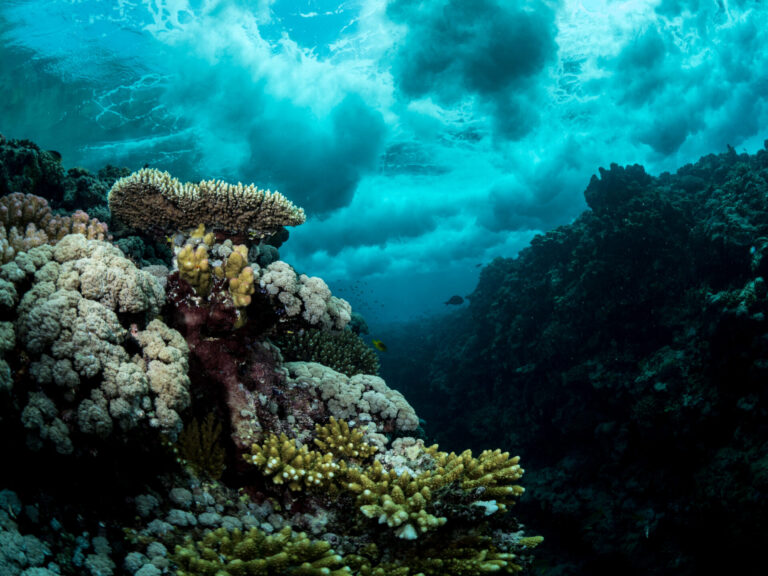Marine Science
The Red Sea models the future
Detailed analysis of nutrient distribution and circulation in the Red Sea could provide a model for the future of the world’s oceans.


The Red Sea is highly saline with low nutrient availability, resulting in crystal clear waters. Coral reefs have adapted to thrive here, and KAUST’s researchers are examining these and other organisms to understand how they survive under such extreme conditions.
© 2015 KAUST
The health of oceanic ecosystems relies on a delicately balanced supply of nutrients, such as nitrogen and carbon distributed around the globe by oceanic, atmospheric and biological circulation. As the effects of global warming take hold, increased disruption of this precarious “nutrient cycle” is likely, with severe knock-on effects in the world’s oceans.
Scientists at KAUST are collaborating on research to understand and model nutrient cycling in the Red Sea, and aim to potentially provide a model for future healthy oceans.
The Red Sea is located in an arid to semi-arid zone between Africa and Asia. With high levels of evaporation, a narrow opening to the Arabian Sea and no rivers to contribute nutrients from the surrounding land, the Red Sea is highly saline and nutrient poor — an “ultra-oligotrophic” environment. Organisms such as corals and photosynthetic plankton have adapted to thrive under these extreme conditions. As climate change takes hold, other ecosystems could become more like the Red Sea.
“Similar oligotrophic environments are found in ocean basins — deep, isolated areas that are very difficult to reach,” said Carlos Duarte, a professor in KAUST’s Red Sea Research Center. “Despite representing 70 percent of the world’s ocean environment, these systems are still poorly understood. It was only recently that we uncovered details of deep-sea carbon cycling in the Atlantic and Pacific, for example.”
Duarte’s current research focuses on sources of nutrients for the Red Sea, including the role that dust from the surrounding deserts plays in propelling Red Sea productivity. Starting in early 2016, he plans to survey nutrient status in coastal habitats.
KAUST Associate Professor Ibrahim Hoteit, who models oceanic and atmospheric circulation, focuses on nutrients driven by the Arabian monsoon. He has discovered that more intense monsoons, driven by global warming, could increase fertility in a warmer Red Sea thanks to an increased influx of nutrients imported from the Arabian Sea.
“Model simulations provide an efficient way to investigate the link between the large-scale variability of the atmosphere and ocean and the flux of nutrients that control primary production,” Hoteit explained. “We also recently developed a 3D-coupled physical-biological model that can simulate the pathways of dissolved inorganic nutrients, the fate of organic matter and how different groups of organisms — plankton and bacteria, for example — behave as a result.”
Hoteit is also involved in a longer-term project with Duarte and KAUST Professor Susana Agusti, in which they are monitoring the effects of global warming on the Red Sea.
Using 30 years of data from remote sensing satellites, the team has gathered evidence of abrupt temperature increases in surface waters since the early 1990s. Such dramatic temperature changes could push organisms beyond their current tolerance levels. Increased temperatures can reduce oxygen solubility in the water, added Duarte, which adds pressure on the marine creatures living there.
There is also considerable value in understanding how photosynthetic plankton and other organisms have adapted to the extreme conditions of the Red Sea.
“Low nutrient availability may actually reduce the stress generated by warming,” said Agusti. “I plan to analyze whether, by slowing the growth of photosynthetic plankton, low nutrient availability in the Red Sea provides a coping mechanism for warming. This would be disrupted if there were increased nutrient-rich influxes into the area.”
Another crucial feature of the Red Sea ecosystem is the coral reefs, the research focus of KAUST’s Associate Professor Christian Voolstra. He investigates how the close relationship between corals and their algal and bacterial symbionts might be affected by changes in temperature and nutrient cycling. In a recent review paper, Voolstra’s team proposed that the control of nitrogen is vital to the functioning of corals.
“Nitrogen is usually sparse in the Red Sea, and we think corals control their associated symbionts by restricting their nitrogen access,” Voolstra said. “With increased water temperatures and the associated influxes of nutrients, this delicate balance is disturbed, increasing coral disease and coral bleaching, or the loss of the algal symbionts.”
KAUST researchers are rising to the challenge of disentangling the complexities of such a dynamic system. Their efforts should pay off in providing a model of how alterations in nutrient cycling and temperature change may affect the world’s oceanic environments in the future.
You might also like

Marine Science
A place to trial hope for global reef restoration

Marine Science
Reef-building coral shows signs of enhanced heat tolerance

Marine Science
Plastic-munching bacteria found across the seven seas

Marine Science
AI reveals the universal beauty of coral reef growth

Marine Science
Tiny crabs glow to stay hidden

Marine Science
Mass fish deaths linked to extreme marine heatwave in Red Sea

Marine Science
Weeding out the secrets of Red Sea macroalgae

Bioscience



